The Intel Kaby Lake-X i7 7740X and i5 7640X Review: The New Single-Threaded Champion, OC to 5GHz
by Ian Cutress on July 24, 2017 8:30 AM EST- Posted in
- CPUs
- Intel
- Kaby Lake
- X299
- Basin Falls
- Kaby Lake-X
- i7-7740X
- i5-7640X
Ashes of the Singularity: Escalation
Seen as the holy child of DirectX12, Ashes of the Singularity (AoTS, or just Ashes) has been the first title to actively go explore as many of DirectX12s features as it possibly can. Stardock, the developer behind the Nitrous engine which powers the game, has ensured that the real-time strategy title takes advantage of multiple cores and multiple graphics cards, in as many configurations as possible.
As a real-time strategy title, Ashes is all about responsiveness during both wide open shots but also concentrated battles. With DirectX12 at the helm, the ability to implement more draw calls per second allows the engine to work with substantial unit depth and effects that other RTS titles had to rely on combined draw calls to achieve, making some combined unit structures ultimately very rigid.
Stardock clearly understand the importance of an in-game benchmark, ensuring that such a tool was available and capable from day one, especially with all the additional DX12 features used and being able to characterize how they affected the title for the developer was important. The in-game benchmark performs a four minute fixed seed battle environment with a variety of shots, and outputs a vast amount of data to analyze.
For our benchmark, we run a fixed v2.11 version of the game due to some peculiarities of the splash screen added after the merger with the standalone Escalation expansion, and have an automated tool to call the benchmark on the command line. (Prior to v2.11, the benchmark also supported 8K/16K testing, however v2.11 has odd behavior which nukes this.)
At both 1920x1080 and 4K resolutions, we run the same settings. Ashes has dropdown options for MSAA, Light Quality, Object Quality, Shading Samples, Shadow Quality, Textures, and separate options for the terrain. There are several presents, from Very Low to Extreme: we run our benchmarks at Extreme settings, and take the frame-time output for our average, percentile, and time under analysis.
For all our results, we show the average frame rate at 1080p first. Mouse over the other graphs underneath to see 99th percentile frame rates and 'Time Under' graphs, as well as results for other resolutions. All of our benchmark results can also be found in our benchmark engine, Bench.
MSI GTX 1080 Gaming 8G Performance
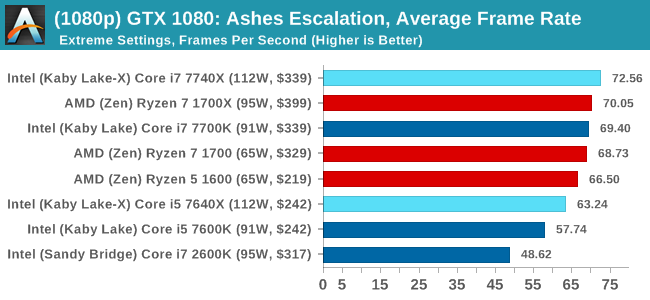
1080p

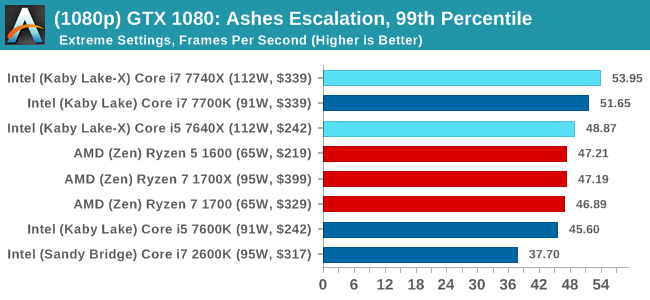
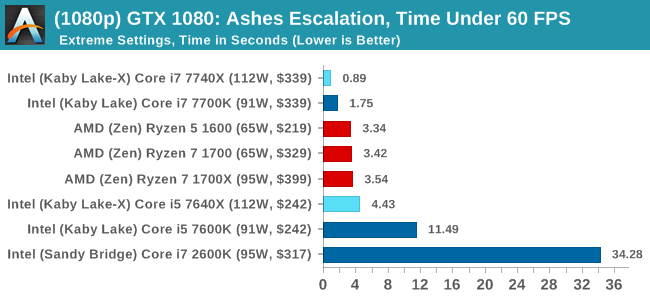
4K
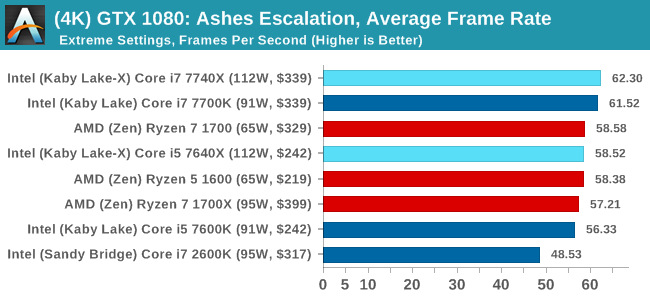
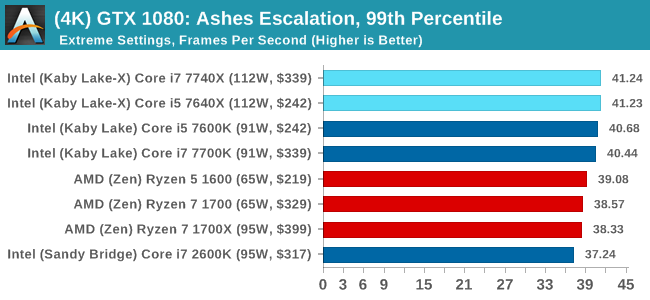
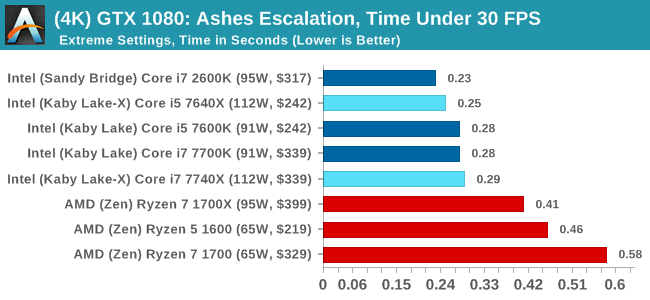
ASUS GTX 1060 Strix 6GB Performance

1080p

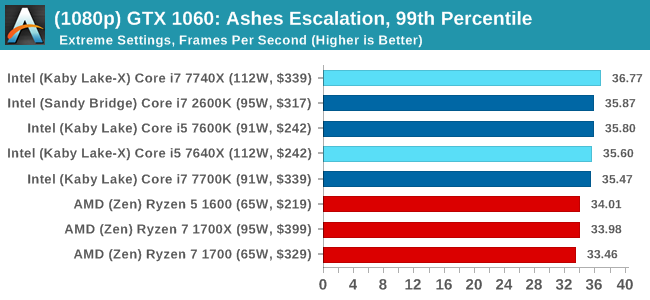
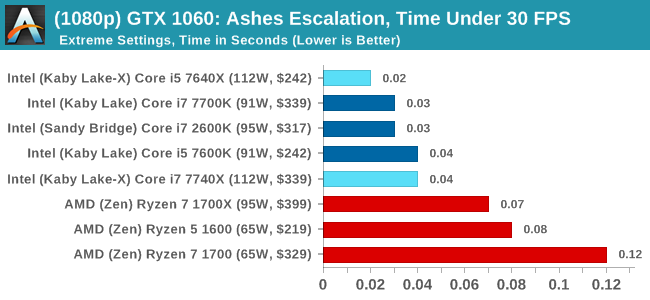
4K
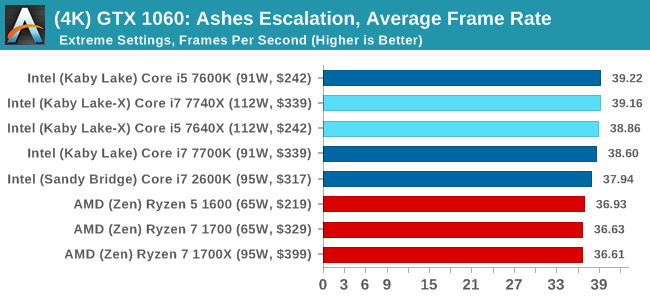
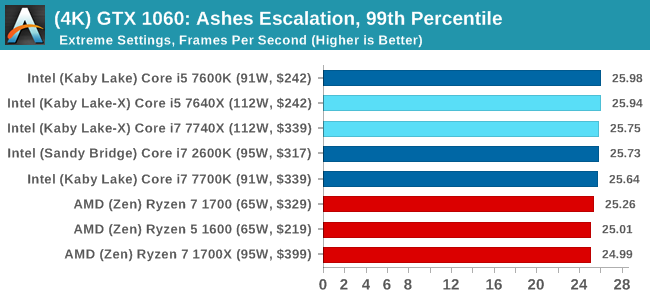

Sapphire R9 Fury 4GB Performance
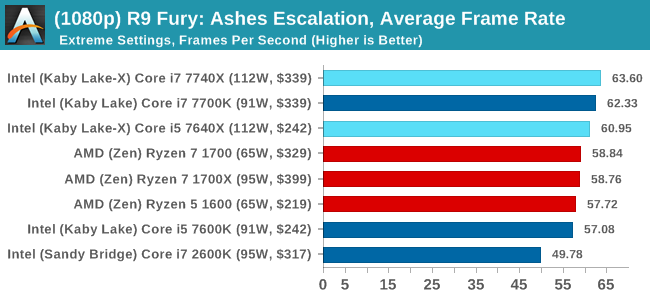
1080p

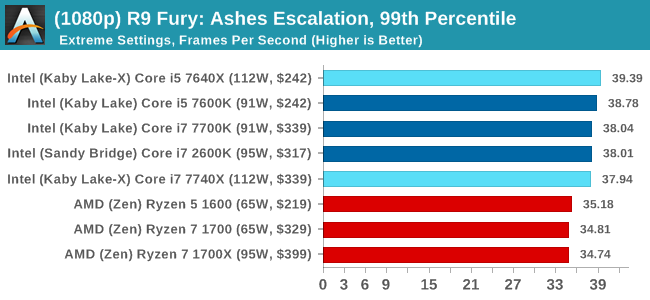

4K
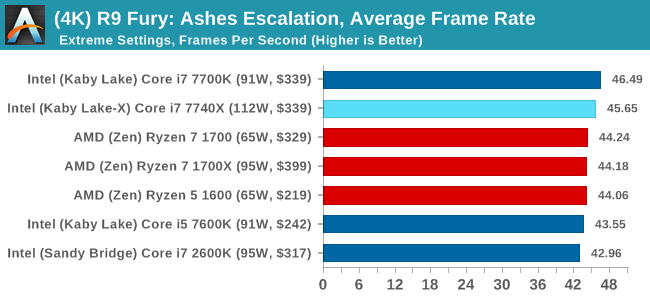

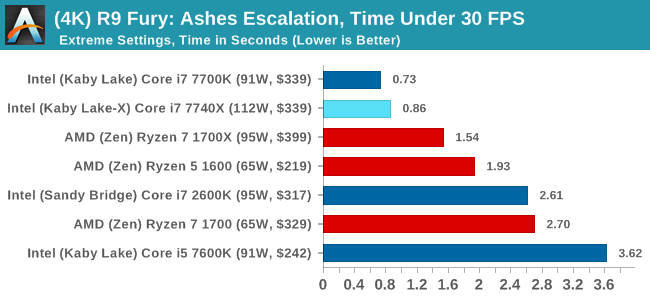
Sapphire RX 480 8GB Performance
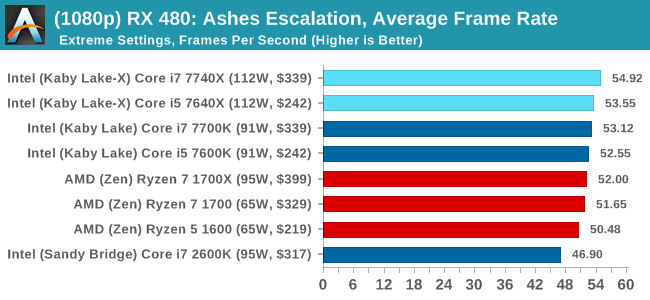
1080p

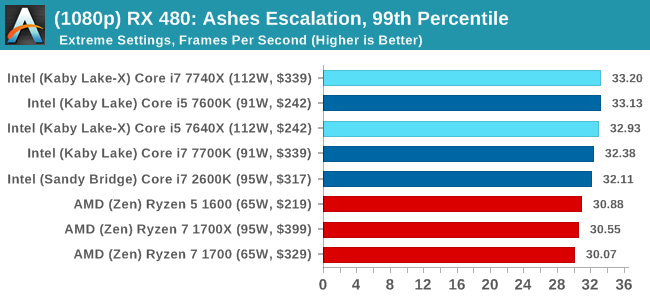
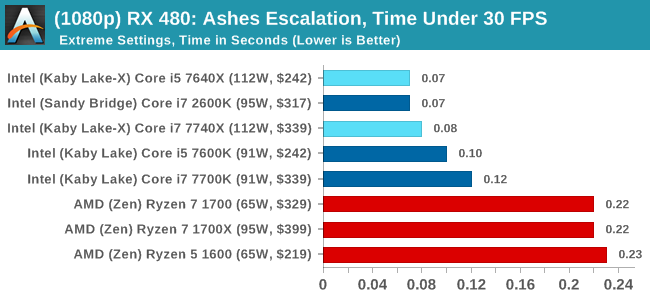
4K
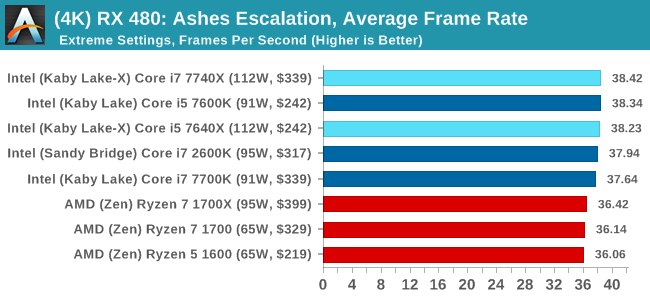
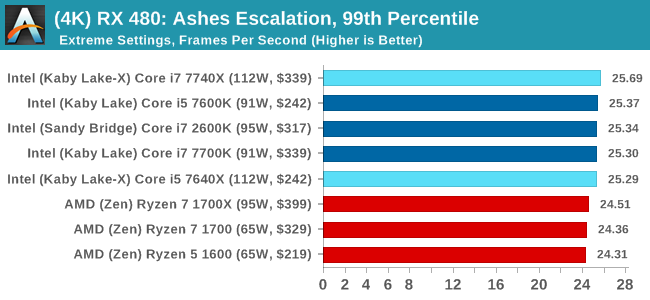

Ashes Conclusion
Pretty much across the board, no matter the GPU or the resolution, Intel gets the win here. This is most noticable in the time under analysis, although AMD seems to do better when the faster cards are running at the lower resolution. That's nothing to brag about though.












176 Comments
View All Comments
mapesdhs - Monday, July 24, 2017 - link
Let the memes collide, focus the memetic radiation, aim it at IBM and get them to jump into the x86 battle. :Ddgz - Monday, July 24, 2017 - link
Man, I could really use an edit button. my brain has shit itselfmapesdhs - Monday, July 24, 2017 - link
Have you ever posted a correction because of a typo, then realised there was a typo in the correction? At that point my head explodes. :DGlock24 - Monday, July 24, 2017 - link
"The second is for professionals that know that their code cannot take advantage of hyperthreading and are happy with the performance. Perhaps in light of a hyperthreading bug (which is severely limited to minor niche edge cases), Intel felt a non-HT version was required."This does not make any sense. All motherboards I've used since Hyper Threading exists (yes, all the way back to the P4) lets you disable HT. There is really no reason for the X299 i5 to exist.
Ian Cutress - Monday, July 24, 2017 - link
Even if the i5 was $90-$100 cheaper? Why offer i5s at all?yeeeeman - Monday, July 24, 2017 - link
First interesting point to extract from this review is that i7 2600K is still good enough for most gaming tasks. Another point that we can extract is that games are not optimized for more than 4 core so all AMD offerings are yet to show what they are capable of, since all of them have more than 4 cores / 8 threads.I think single threading argument absolute performance argument is plain air, because the differences in single thread performance between all top CPUs that you can currently buy is slim, very slim. Kaby Lake CPUs are best in this just because they are sold with high clocks out of the box, but this doesn't mean that if AMD tweaks its CPUs and pushes them to 5Ghz it won't get back the crown. Also, in a very short time there will be another uArch and another CPU that will have again better single threaded performance so it is a race without end and without reason.
What is more relevant is the multi-core race, which sooner or later will end up being used more and more by games and software in general. And when games will move to over 4 core usage then all these 4 cores / 8 threads overpriced "monsters" will become useless. That is why I am saying that AMD has some real gems on their hands with the Ryzen family. I bet you that the R7 1700 will be a much better/competent CPU in 3 years time compared to 7700K or whatever you are reviewing here. Dirt cheap, push it to 4Ghz and forget about it.
Icehawk - Monday, July 24, 2017 - link
They have been saying for years that we will use more cores. Here we are almost 20 years down the road and there are few non professional apps and almost no games that use more than 4 cores and the vast majority use just two. Yes, more cores help with running multiple apps & instances but if we are just looking at the performance of the focused app less cores and more MHz is still the winner. From all I have read the two issues are that not everything is parallelizable and that coding for more cores/threads is more difficult and neither of those are going away.mapesdhs - Monday, July 24, 2017 - link
Thing is, until now there hasn't been a mainstream-affordable solution. It's true that parallel coding requires greater skill, but that being the case then the edu system should be teaching those skills. Instead the time is wasted on gender studies nonsense. Intel could have kick started this whole thing years ago by releasing the 3930K for what it actually was, an 8-core CPU (it has 2 cores disabled), but they didn't have to because back then AMD couldn't even compete with mid-range SB 2500K (hence why they never bothered with a 6-core for mainstream chipsets). One could argue the lack of market sw evolvement to exploit more cores is Intel's fault, they could have helped promote it a long time ago.cocochanel - Tuesday, July 25, 2017 - link
+1!!!twtech - Monday, July 24, 2017 - link
What can these chips do with a nice watercooling setup, and a goal of 24x7 stability? Maybe 4.7? 4.8?These seem like pretty moderate OCs overall, but I guess we were a bit spoiled by Sandy Bridge, etc., where a 1GHz overclock wasn't out of the question.